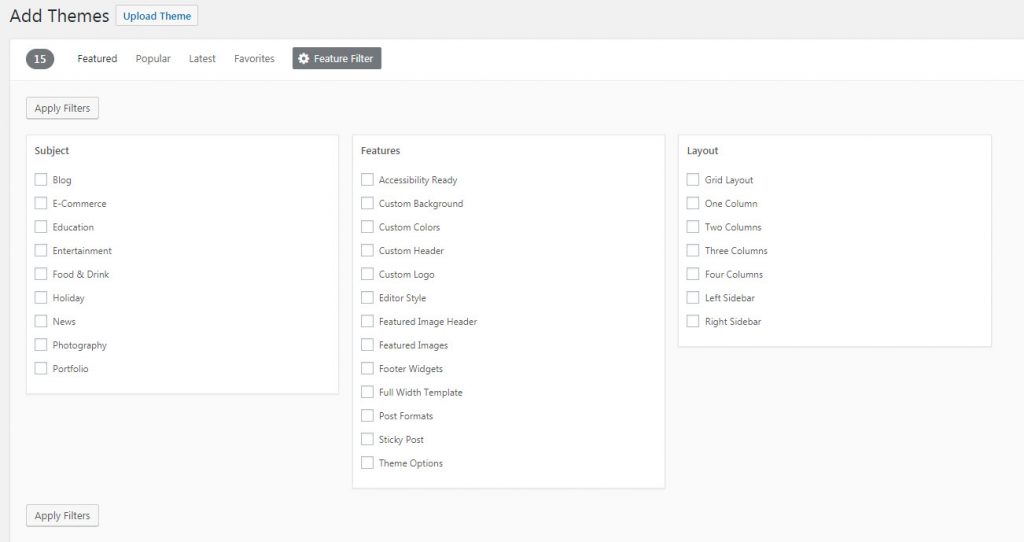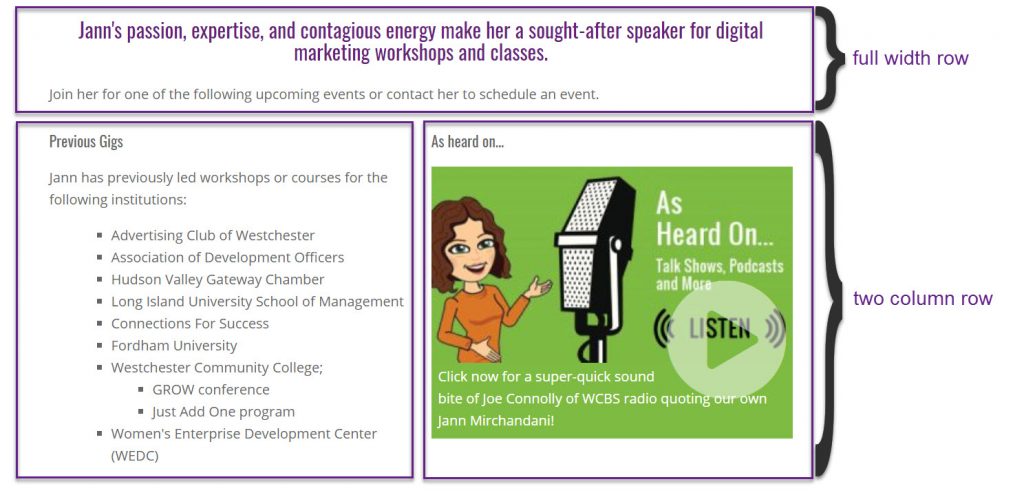
Read time: 8 minutes, 57 seconds
WordPress is by far the most popular website platform out there. According to W3techs, WordPress has 58.55% of the Content Management System (CMS) market share, more than all other systems (e.g., Drupal, Joomla, Wix, Squarespace) combined, and is the platform for a full one-third of all websites on the web.
But not all WordPress websites are created equal. We’ve seen some great sites and we’ve seen some duds. Let’s take a look at what WordPress is and what makes WordPress websites great!
WordPress 101
WordPress is “open source” allowing users to freely distribute and modify the original code. This means that while you still need to register your domain and set up hosting there is no cost for the “software” itself.
Being open source makes possible the development of plugins. A plugin is like a remote starter for your car; it is installed by someone other than the original manufacturer and adds a new feature. This keeps the core files – those essential to WordPress – relatively lean but allows users to add a myriad of functions quickly and easily.
There is no official WordPress support per se, however, the WordPress community is incredibly active. WordPress developers and users from around the world attend various WordCamps; conferences for everything WordPress. There are nine WordCamps in June alone from Ohio to Brazil to Canada.
In addition, there are numerous blogs and forums in addition to the official WordPress codex that provide detailed information for users of every level of expertise.
Why Build With WordPress?
Documentation
Because the WordPress community is so active there is a lot of documentation.
The WordPress Codex is “the online manual for WordPress and a living repository for WordPress information and documentation.” It is a bit technical, as you might expect, but it contains just about everything you need to know to add and change and build features on the platform.
There are also numerous forums and blogs that provide information on using and improving the platform. Theme and plugin-specific sites exist where users can ask questions and other users provide feedback and suggestions.
Themes
Themes are a set of page templates and styles sheets that define the way a site will look. There are literally thousands of themes to choose from. Many sectors have industry-specific themes designed with them in mind. And many allow customization of fonts and colors from within the dashboard.
Many themes are free and can be interchanged easily. There are also numerous paid themes that offer varying levels of support from the developer.
Plugins
As of May 2019, there are some 54,956 plugins available from WordPress.org. These plugins add specific functions to WordPress such as:
- creating an integrated calendar with or without event registration options
- “smart” forms that use conditional logic to hide or show fields based on responses to various questions
- the ability to easily add Google Analytics or other snippets of code without touching core files
Most are free or low-cost. And if there isn’t a plugin already that does what you need it to do, you can have a developer create one.
Widgets
Widgets are jiffy little blocks that perform a precise function in an exact location. An opt-in form is a good example. The form can be added using a widget on the blog sidebar.
Many WordPress themes have “widgetized areas” that allow you to drag and drop a variety of widgets into your header, footer or sidebar.

Pricing
There is no cost for WordPress; no licensing fees, no software to purchase. There are some expenses, however, including domain registration, hosting, and any paid plugins or themes. As with any website, additional marketing or tech support is also additional.
Easy To Use
One of the main reasons we like WordPress is that is is easy for our clients to use. You don’t need to understand coding or be especially “techy” to be able to login and add or change content.
Which brings me to the main topic.
Not All WordPress Sites Are Created Equal
We’ve seen examples of bad themes, bad plugins, and bad development each or collectively wreaking havoc with what would otherwise be a straightforward project.
Bad Themes
With so many themes available, how do you narrow down your search to select the right one?
- Select the features you need
- Avoid a lot of extras
Selecting features you need
You can select from a number of basic filters to narrow down your search.

Filter your search by subject matter. You can obviously add any content to any theme so if you’re looking for a particular type of aesthetic you may want to include more subjects in your filter.
Limit your search to particular features. For example, you may want to find a theme that is accessibility-ready or one that allows you to include widgets in the footer or header.
Select an exact layout. In general, a simple layout is better than a more complex one.
Oddly, responsive design is not an option for filtering themes. But you certainly want to make sure whatever theme you select is responsive.
Avoid Bloated Themes
A bloated theme contains extraneous code that negatively impacts your site’s performance.
You will undoubtedly see numerous super-slick demo sites that offer a wide variety of attractive elements. You’ll see a feature-rich home page that includes elements that you don’t need and likely won’t use. Or worse, you’ll end up creating fluff to fill the space.
Select an attractive theme that will accomplish your communication goals. Don’t communicate based on the blank spaces the theme has created.
Some themes come with their own page-builders built in. Page builders are plugins that allow you to, well, build your page, using a drag and drop interface. They create the maximum flexibility for modular page layout, such as creating full-width content followed by side-by-side columns followed by more full-width content as in the image below.

The downside to some page-builder plugins is they can create a ton of bloat and leave a mess if you deactivate the plugin. Some will leave your content unusable or require a big clean-up.
Selecting a more commonly-used page-builder plugin, as opposed to a theme’s custom-built plugin, will avoid problems down the road.
Bad Plugins
WordPress and its plugins are like any software in that security flaws and bugs crop up. It’s important to note, most of these vulnerabilities are quickly patched and updates made available.
Having said that, it is important to avoid plugins that are not actively maintained or have not been tested with the latest version of WordPress. (You’re updated to the latest version, right?!)
Plugins that are not actively maintained do not have anyone monitoring them to address security or compatibility issues that may be discovered.
Using plugins that are updated frequently and tested with the latest version of WordPress will help you to avoid these issues.
Bad Development
Here’s the real rub. WordPress is meant to be easy to use and highly flexible. We have seen numerous sites, however, that seem as if they are built to be difficult to work with. Some of the issues we’ve seen include:
- clients without admin access to their own website
- themes that required clients to make edits using HTML
- “news feeds” that were manually created lists rather the automatically updated post loops
I’d like to think that these sites were the result of the inexperience of the designer/developer. But the truth is at least some seem to be the result of vendors not wanting clients to be able to access their content; they want to be indispensable.
Building a Better WordPress Website
We’ve been building WordPress websites for clients for ten years now. One of the reasons we love using it is because it can grow with our clients. Here’s how we ensure that happens.
Have a Plan
WordPress makes it easy to get up-and-running fairly quickly. That doesn’t mean you should run before you walk, however.
A strategy for content development, site maintenance, and ease-of-use are essential for a successful website development project. Before you start building a house, you need a blueprint, right? Your website should also have a blueprint before you start building.
Business Blogging
Fresh, relevant content is essential for Search Engine Optimization. That means your website will need room to grow to accommodate new content over the course of months and years. All that information needs to go somewhere without creating a mess of the navigational menu.
Building on our house metaphor (if you’ll pardon the pun,) think of constructing a house for yourself and your spouse. For now you don’t need much space, nor do you have a lot of money, so you build small. But you know down the road you will need additional space for children and aging parents so you will eventually need to add on to your small home. By identifying now where those new rooms will be in the future you create room to grow and avoid unnecessary disruption.
This is how we think about website content. We use the “blog” as a way of starting small now but planning big for the future.
New content is organized by Category within the blog which becomes, in essence, a Newsfeed; newer content is highly visible and pushes down, but does not replace, older content. Everything is still accessible providing SEO benefits and the navigational structure maintains its integrity.
Some of the ways we’ve used Categories include:
- events pages; each event is its own Post with all relevant information such as date, time and location. Individual events are then automatically added to a list of upcoming events on an Event Page.
- case studies; new projects are used to create case studies and a featured project page showcases a list of recent projects
- press releases; a press release is created to highlight recent business activities and they are listed in reverse chronological order on a Newsroom page.
- recipes; new recipes are added as posts and organized into individual pages by meal, i.e. Breakfast, Lunch, Dinner
Keep It Simple
Plugins can save oodles of time and energy. However, they aren’t always necessary and they require updates. In addition, they can sometimes run into compatibility issues. In some cases, they can slow down the site’s load time.
Because of this, we keep the number of plugins we use to a minimum and we select them carefully when we do use them. And we make sure to remove any plugins we are no longer using.
Putting the Pieces Together
To sum up, WordPress is so popular because it is easy to use, flexible and can grow with your organization. But to maximize a WordPress website requires planning and strategy.
Want to know more?
Here are some great resources to get you up to speed on all things WordPress.
- WordCamp Central; information about upcoming WordCamps.
- WPBeginner; a free WordPress resource site for Beginners. Founded by Syed Balkhi.
- WordPress Codex; official documentation for WordPress.
- “Should I Use A WordPress PageBuilder Plugin”: Discussing the pros and cons, by Nick Schaäferhoff at Torque Magazine
Are you able to easily update your website and keep your content well organized? If not, contact us to see how we can help.
Pingback: Editorial Calendar | Content Creation Tool | Westchester Marketing Cafe